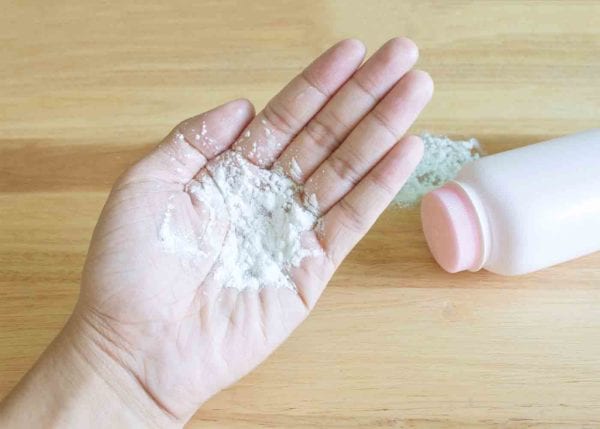01. Talcum Powder and Asbestos
为什么在滑石粉石棉?
Talc powder products have been on the market since the 1800s. However, the safety of talcum powder has been called into question in recent years. Pure talc on its own is considered safe, but asbestos-contaminated talc has been a public health concern for decades.
Talc andasbestosnaturally occur near each other in the earth. When mined, raw talc may contain asbestos fibers. Talc is commonly contaminated withamphibole asbestos。Studies found exposure to the five types of asbestos in this category is more likely to lead to asbestos-related diseases.
According to the U.S. Food and Drug Administration (FDA), the questions surrounding asbestos-contaminated talc have been raised since the 1970s.
In 1973, the FDA developed new standards stating talc should be tested to ensure it is asbestos-free talc. The law remains in place today. However, the FDA does not currently require testing of talc cosmetics for asbestos before they are added to store shelves. Once a product is on the market, the FDA monitors for safety.
Today, talc products continue to test positive for asbestos fibers. Independent testing completed by The Environmental Working Group (EWG) in 2020 found15% of the talc cosmetics sampled contained asbestos fibers。As a result, workers and consumers continue to be at risk for asbestos exposure and related diseases.
石棉在滑石粉History At-a-Glance
- Other Names:Talc, talc powder, cosmetic talc, baby powder, body powder
- Years of Manufacture:1800s – Present
- Places Used:Personal care products, cosmetic products, consumer uses, industrial uses
- Asbestos Use Banned:No
- Noteworthy Brands & Distributors:Johnson & Johnson; Colgate-Palmolive; Whittaker, Clark and Daniels
Dangers of Asbestos in Talcum Powder
Studies first emerged in the 1970s linking contaminated talc to serious health risks, such as cancer. Doctors noted many instances ofovarian cancerrevealed talc particles within tumors. They reasoned the talc created an increased risk for ovarian and other types of cancer.
多年来,有争论cancer connection. More studies and agencies, including the International Agency for Research on Cancer (IARC), have confirmedcontaminated talc is a carcinogen。
When consumers use these asbestos-containing products, they risk exposure to friable asbestos fibers. The powder form of the contaminated talcum powder may increase the risk of inhaling or ingesting asbestos. Many concerned consumers have also claimed they relied on these talc products for decades. This may indicate long-term exposure to asbestos-contaminated talc products.
Once in the body, the asbestos fibers can lead to several diseases, including:
As a result, thousands of consumers have filed lawsuits against Johnson & Johnson and other manufacturers of these products. More than 9,000 of these cases are due to consumers developing ovarian cancer after using these products. Recently, more cases are emerging tying asbestos talcum powder to mesothelioma and lung cancer. A number of these asbestos talcum powder lawsuits have led to large verdicts for the claimants.
02. List of Asbestos Talc Products
Talc Products Known to Contain Asbestos
Exposure to asbestos-contaminated talc most notably occurs through the use of contaminated talcum powder products, such as talc-based baby powders. However, contaminated talc may also be used in cosmetics and for industrial purposes. Examples of industrial uses include ceramics and plastics. Below is a list of notable asbestos-contaminated talcum powder products.
- Bauer & Black Baby Talc
- Cashmere Bouquet Body Talc
- Clubman Talcum Powder
- Coty Airspun Face Powder
- Desert Flower Dusting Powder
- English Leather After Shave Talc
- Faberge Brut Talc
- Friendship Garden Talcum Powder
- Mennen Shave Talc
- Old Spice Talcum Powder
- Rosemary Talc
- Yardley Invisible Talc
- Yardley Black Label Baby Powder
- ZBT Baby Powder with Baby Oil
Many companies were involved in the development and production of the above products. These companies may have exposed workers and consumers to asbestos-contaminated talc products.
Johnson & Johnson Ending Sale of Talc-Based Baby Powder in North America
Johnson & Johnson has been a manufacturer of talc products for decades. In May 2020, the company announced it would be ending the sale of talc-based baby powder in North America. For years, Johnson & Johnson has faced lawsuits related to the safety of this product.
Many plaintiffs cite trace amounts of asbestos in the talcum powder as the cause of their cancer. Despite these claims, the company has maintained the safety of its talcum powder products.
According to a 2018Reutersreport, Johnson & Johnson talc sometimes tested positive for asbestos from the 1970s to the early 2000s. The company failed to notify the public.
Some feel Johnson & Johnson’s decision to stop selling its product in North America is an admission of guilt. According to Johnson & Johnson, this change is a result of a decline in demand for talc-based baby powder. The company says it will continue to defend the product within the court system.
Johnson & Johnson’s cornstarch-based baby powder will remain on the market in North America. The company will continue to sell its talc-based product elsewhere across the globe.
Asbestos diseases, such as mesothelioma, havelong latency periods。As a result, individuals exposed to Johnson & Johnson contaminated products in the past may still be at risk of developing a disease.
Other Uses of Asbestos-Contaminated Talc
许多石棉相关诉讼源于滑石are a result of the use of talcum powders. However, asbestos talc may also be found in makeup and industrial uses.
03. Talcum Powder & Asbestos Exposure
Who Is at Risk of Asbestos Exposure From Talcum Powder?
Consumers who use talcum powder may unknowingly experienceasbestos exposure。Many consumers use these products for decades. No amount of asbestos exposure is safe. But long-term exposure to asbestos is often more likely to cause asbestos-related diseases.
In addition to those directly using talc products,secondary exposuremay occur among family members. For example, a person may use talcum powder each morning after showering. The next family member in the bathroom may then inhale or ingest asbestos fibers left in the air.
In addition to consumers, miners may also experience asbestos exposure when mining talc ore. Manufacturer workers may be exposed during production of talc products. Thisoccupational asbestos exposuremay also be long-term, with exposure occurring over a decades-long career.
Potential exposure to contaminated talcum powder continues today. Consumers remain at risk through talcum powder and use of talc-containing cosmetics, such as eyeshadow.
04. Asbestos Lawsuits
Asbestos Lawsuits, Settlements & Other Compensation
Individuals diagnosed with an asbestos-related disease following exposure to asbestos-contaminated talcum powder may be eligible forcompensation。In the event of a patient’s passing, family members may alsofile a mesothelioma claim。
Anexperienced asbestos lawyercan help individuals discern the best compensation option for them. If the company is still in business, such as Johnson & Johnson, alawsuitmay be a viable option. Johnson & Johnson has been named in thousands of lawsuits stemming from its talc products. These lawsuits may result inmesothelioma settlementsor jury verdicts.
这些赔偿lawsuits may help cover treatment costs, lost wages or pain and suffering.
Some talc suppliers have filed for bankruptcy due to their talc-related liabilities. However, victims may still be eligible for compensation. For instance, The North American Talc Subsidiaries of Imerys, a major supplier of talc to Johnson & Johnson, filed for Chapter 11 bankruptcy in 2019.
The talc supplier released a plan for reorganization in May 2020.Asbestos companiessometimes begintrust funds to pay claimantswhen emerging from bankruptcy. The North American Talc Subsidiaries of Imerys will form an asbestos trust to compensate victims.
Lawyers can help individuals determine the best compensation option for their situation.
Compensation Following Asbestos Exposure From Talcum Powder
Many individuals have successfully filed claims against companies producing asbestos-contaminated talcum powder.
In 2015, Judith Winkel was awarded $13 million inCaliforniacourt. She filed a mesothelioma lawsuit against Colgate-Palmolive. Winkel developed mesothelioma due toher regular use of Cashmere Bouquet。
Whittaker, Clark and Daniels has also faced lawsuits. The company distributed asbestos-contaminated talc to the manufacturers of Desert Flower and Clubman talcum powders. Whittaker, Clark and Daniels paid $7 million and $18 million verdicts in 2015 and 2016, respectively. At the time, the $18 million verdict was the largest award for mesothelioma caused by cosmetic talc.
In spring 2018, Johnson & Johnson faced its second asbestos talcum powder lawsuit connected to amesothelioma diagnosis。Stephen Lanzo filed the claim. He developed mesothelioma after regularly using Johnson & Johnson’s baby powder products since the 1970s.
The case marked the first guilty verdict against Johnson & Johnson for this type of mesothelioma lawsuit. Lanzo’s case resulted in a$117 million verdict, with $80 million of the verdict due to punitive damages.
In November 2020,Johnson & Johnson was ordered to pay $120 million in damagesto another mesothelioma victim. Donna Olson was diagnosed with mesothelioma after using Johnson & Johnson’s baby powder or Shower to Shower product for more than 50 years. She and her husband were awarded:
- $15 million in compensatory damages
- $105 million in punitive damages
The guilty verdict was upheld by the state supreme court inManhattan, New York。Johnson & Johnson said they will appeal the verdict.
Despite these verdicts and other ongoing lawsuits, Johnson & Johnson and other talc powder manufacturers stand by the safety of their products. Courts continue to hear cases calling forstricter talc regulationsto ensure product safety and protect consumers and workers.
Those concerned about asbestos-contaminated talc may choose to avoid talc-containing products as a precaution.





